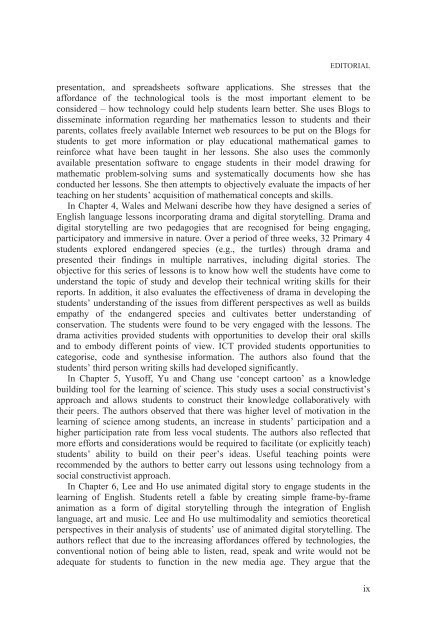1517-creating-holistic-technology-enhanced-learning-experiences
1517-creating-holistic-technology-enhanced-learning-experiences
1517-creating-holistic-technology-enhanced-learning-experiences
You also want an ePaper? Increase the reach of your titles
YUMPU automatically turns print PDFs into web optimized ePapers that Google loves.
EDITORIAL<br />
presentation, and spreadsheets software applications. She stresses that the<br />
affordance of the technological tools is the most important element to be<br />
considered – how <strong>technology</strong> could help students learn better. She uses Blogs to<br />
disseminate information regarding her mathematics lesson to students and their<br />
parents, collates freely available Internet web resources to be put on the Blogs for<br />
students to get more information or play educational mathematical games to<br />
reinforce what have been taught in her lessons. She also uses the commonly<br />
available presentation software to engage students in their model drawing for<br />
mathematic problem-solving sums and systematically documents how she has<br />
conducted her lessons. She then attempts to objectively evaluate the impacts of her<br />
teaching on her students’ acquisition of mathematical concepts and skills.<br />
In Chapter 4, Wales and Melwani describe how they have designed a series of<br />
English language lessons incorporating drama and digital storytelling. Drama and<br />
digital storytelling are two pedagogies that are recognised for being engaging,<br />
participatory and immersive in nature. Over a period of three weeks, 32 Primary 4<br />
students explored endangered species (e.g., the turtles) through drama and<br />
presented their findings in multiple narratives, including digital stories. The<br />
objective for this series of lessons is to know how well the students have come to<br />
understand the topic of study and develop their technical writing skills for their<br />
reports. In addition, it also evaluates the effectiveness of drama in developing the<br />
students’ understanding of the issues from different perspectives as well as builds<br />
empathy of the endangered species and cultivates better understanding of<br />
conservation. The students were found to be very engaged with the lessons. The<br />
drama activities provided students with opportunities to develop their oral skills<br />
and to embody different points of view. ICT provided students opportunities to<br />
categorise, code and synthesise information. The authors also found that the<br />
students’ third person writing skills had developed significantly.<br />
In Chapter 5, Yusoff, Yu and Chang use ‘concept cartoon’ as a knowledge<br />
building tool for the <strong>learning</strong> of science. This study uses a social constructivist’s<br />
approach and allows students to construct their knowledge collaboratively with<br />
their peers. The authors observed that there was higher level of motivation in the<br />
<strong>learning</strong> of science among students, an increase in students’ participation and a<br />
higher participation rate from less vocal students. The authors also reflected that<br />
more efforts and considerations would be required to facilitate (or explicitly teach)<br />
students’ ability to build on their peer’s ideas. Useful teaching points were<br />
recommended by the authors to better carry out lessons using <strong>technology</strong> from a<br />
social constructivist approach.<br />
In Chapter 6, Lee and Ho use animated digital story to engage students in the<br />
<strong>learning</strong> of English. Students retell a fable by <strong>creating</strong> simple frame-by-frame<br />
animation as a form of digital storytelling through the integration of English<br />
language, art and music. Lee and Ho use multimodality and semiotics theoretical<br />
perspectives in their analysis of students’ use of animated digital storytelling. The<br />
authors reflect that due to the increasing affordances offered by technologies, the<br />
conventional notion of being able to listen, read, speak and write would not be<br />
adequate for students to function in the new media age. They argue that the<br />
ix


